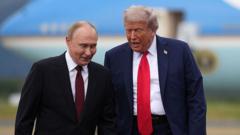A U.S. report indicates that recent airstrikes on Iranian nuclear sites had a modest effect on their operations, coinciding with a fragile cease-fire between Israel and Iran, where both nations are posturing post-conflict.
Insights into Recent U.S. Strikes on Iran Amidst Fragile Truce

Insights into Recent U.S. Strikes on Iran Amidst Fragile Truce
The latest details reveal the limited impact of U.S. airstrikes on Iran's nuclear capabilities as a cease-fire between Iran and Israel takes hold.
A classified report from U.S. intelligence has unveiled that recent airstrikes on three nuclear facilities in Iran have only temporarily hindered the nation’s nuclear capabilities. Despite President Trump's declaration of a mission accomplished, the report suggests that the strikes merely sealed off the entrances of the sites without collapsing their fortified infrastructure. This revelation contradicts Trump's assertions, prompting a White House representative to denounce the assessment as "flat-out wrong."
As the U.S. recognized the limited success of its military intervention, a tenuous cease-fire appeared to be holding, with Israel lifting emergency protocols initiated during the conflict. Iran's President celebrated what he termed the end of a "12-day war," expressing a sense of relief for the Iranian populace. Meanwhile, the conflict saw intermittent strikes from both countries, with each side blaming the other for the flare-up.
Despite the situation, President Trump repositioned himself, lauding both nations for pursuing peace and claiming personal credit for curbing the conflict. In a social media post, he asserted, “It was my great honor to Destroy All Nuclear facilities & capability, and then, STOP THE WAR!” This complex and rapidly evolving narrative poses questions about the future of stability in the Middle East and the effectiveness of U.S. military actions.




















